Starting Position
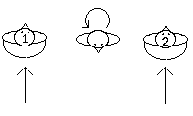
Bars 7-8 (2nd time)
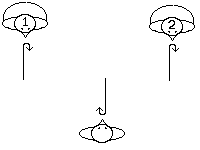
Section III
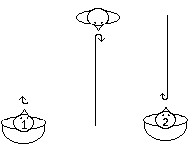
Bars 11-14
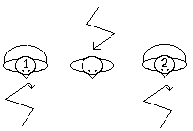
Bars 18-20
| Steps: | Sempio (in 4), Doppio (in 4), Saltarello (in 6), Saltarello Tedesco, Piva (in 6), Ripresa (in 6), Ripresa Portugalesa (in 6), Mezavolta, Voltatonda, Volta del Gioioso, Reverenza, Movimento | Starting Position Start: | Woman 1 on the left, Man in the middle, Woman 2 on the right, holding hands, facing up the hall. | [Two-bar introduction on accompanying tape.] |
 Bars 7-8 (2nd time) 1-4 (twice) | 4 Saltarelli Tedesci, starting Left | 5-8 | Man Sempio Left, Sempio Right, Doppio Left. | 5-6 (2nd time) | Women Sempio Right, Sempio Left. |
 Section III 7-8 (2nd time) | Women Doppio Right, | | |||||||
| as | Man Mezavolta (Doppio Right). (Man is facing down the hall, standing between Women, who are facing up the hall.) | |||||||||||||||||||
| 9-10 | Saltarello Tedesco Left, Saltarello Tedesco Right ending with a Mezavolta Right. (Dancers are about 12 steps apart, Man facing up the hall, Women down.) | |||||||||||||||||||
 Bars 11-14 | ||||||||||||||||||||
| 11-12 | Saltarello Left, Saltarello Right, coming together. (Man is between Women, facing up the hall, while they face down.) | |||||||||||||||||||
| 13-14 | Saltarello Left, Saltarello Right ending with a Mezavolta Right. (Dancers are about 12 steps apart, Men facing down the hall, Women up.) | |||||||||||||||||||
| 15-16 | Ripresa Left, Ripresa Right. | |||||||||||||||||||
| 17 | Reverenza Left, stepping back on the left foot on the last beat. |  Bars 18-20 | ||||||||||||||||||
| 18-19 | 2 Riprese Portugalese, Right and Left, moving forward. | |||||||||||||||||||
| 20 | Ripresa Portugalesa Right forward, Women ending with a Mezavolta Right. (Dancers are in a line again, Man in the middle, all facing down the hall.) | |||||||||||||||||||
| 21 | Ripresa Left. | |||||||||||||||||||
| 22-23 | Volta del Gioioso. | |||||||||||||||||||
| 24 | Reverenza Left. | |||||||||||||||||||
| 25-27 | Man and Woman 1 (the one on his right) take right hands and circle with Piva Left, Piva Right, Piva Left, back to place. | |||||||||||||||||||
| 28-30 | Man and Woman 2 take left hands and circle with Piva Right, Piva Left, Piva Right. | |||||||||||||||||||
| 31 | Man Movimento. | |||||||||||||||||||
| 32 | Women Movimento. | |||||||||||||||||||
| 33-34 | Man Voltatonda (4 Steps, starting Left, counterclockwise, each step taking half a bar.) | |||||||||||||||||||
| 35-36 | Women Voltatonda (same as Man). (Dancers are facing down the hall, Woman 2 on the left.) | |||||||||||||||||||
Recordings
Forse - Four-bar introduction (enough time to do two saltarelli tedesci). Section V is only seven bars long; the easiest modification is to leave out the last reverenza, in Bar 24. The dance is played twice.
Sonare - Four-bar introduction (enough time to do two saltarelli tedesci). Section V is only seven bars long; the easiest modification is to leave out the last reverenza, in Bar 24. The phrasing of Section IV and of Bars 31-36 do not match this reconstruction very well, but the number of bars do, so, when in doubt, count rigorously and all should turn out correctly. The dance is played twice.
Dance Notes
PnA and PnG give the choreographer as Guglielmo, while the three other sources attribute the dance to Domenico.
Bars 1-4 and 9-10: In Bars 1-4 the saltarelli tedesci (which are referred to as doppi in tedesco in all except NYp) are to be done "battendo il tempo inanti" (beating the tempo ahead). In Bars 9-10 all except NYp instructs that they are to be done "battendo il tempo in gallone" (beating the tempo to the flank). This may mean that the meza ripresa of each saltarello tedesco is to be done moving forward in the first section, and later in its normal sideways direction, or at an angle as in the ripresa portugalesa. For this reconstruction a normal saltarello tedesco was chosen.
It is also possible that these instructions have to do with a different way of performing the saltarello tedesco in 6/8 rather than in 4/4 time. It seems unlikely in this case, however, as the first section, although in 6/8 time, uses two bars for one saltarello tedesco, which is equivalent to one bar in 4/4 time.
Bars 5-6 (2nd time): The women are actually instructed to start the sempio on the left, but this would put them on the wrong foot for the saltarello tedesco left, in Bar 9, so it is presumed to be an error.
Bar 17: All the sources except NYp follow the reverenza with a sempio left backwards. This sempio would take an extra half-bar, which is not present in the music. NYp merely says to draw the left foot back, which can easily be added to the same bar as the reverenza, and is clearly required in order to change weight for the next step, which is to the right.
Bars 33-36: The voltatonda is actually given as a doppio; however, NYp adds that they all end it putting the right foot forward. For the repeat of the dance, the dancers will need their left feet free, so adding an extra step to the doppio is required. Rather than referring to it as a doppio and a step we described it as four steps; however, it is possible that it was actually done as a doppio and at the end of the women's doppio all the dancers then put their right feet forward ready to start over. (See also Volta in Piva, in the Voltatonda Section of the Steps Chapter.)
Repeat: As is usual, NYp, Fn and Fl call for a repeat, while PnG and PnA do not. We decided on a repeat, as the dancers end the first time through the dance facing down the hall, and with the women on opposite sides (relative to each other) as when they started. After the repeat they should end exactly as they started.
Music Notes
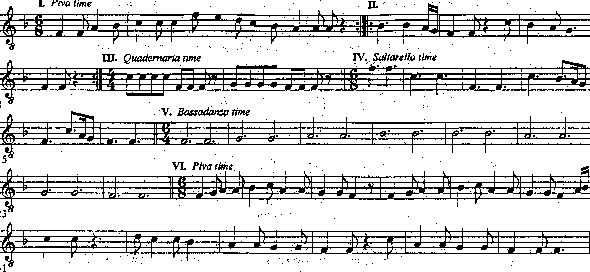
We made several changes to the music for this dance.
In the first section, we made two changes, both by changing semibreves to breves: Bar 2 Note 3, and Bar 3 Note 1. In the latter case, Sparti reports that PnA indicates this change. In both cases we made the change to produce the correct amount of music with sensible barring.
In Bar 5, we "bound" the pair of quavers to the preceeding semibrevis, which resulted in the first semibrevis of the bar being transcribed as a dotted quarter instead of a quarter. Similarly, we transcribed the last note of Bar 7 as a dotted quarter for rhythmic considerations.
The manuscript provided seven bars of music for the bassadanza section (Bars 17-24) but the choreography required eight bars. We added Bar 21 (two Bs) in keeping with the progression of the line.
In Bar 31, the dotted rest is conjecture; treating the following minima as a pickup produced problems later on, so a judgement call is needed.
The first two sections appear, musically, to be in piva or saltarello time; however, the choreography calls for saltarelli tedesco, which are usually done in quadernaria time. As we are treating 6/8 measures in piva time as half the length of measures in quadernaria time, we kept the barring in piva rather than introducing triplet notation or unusual time signatures.